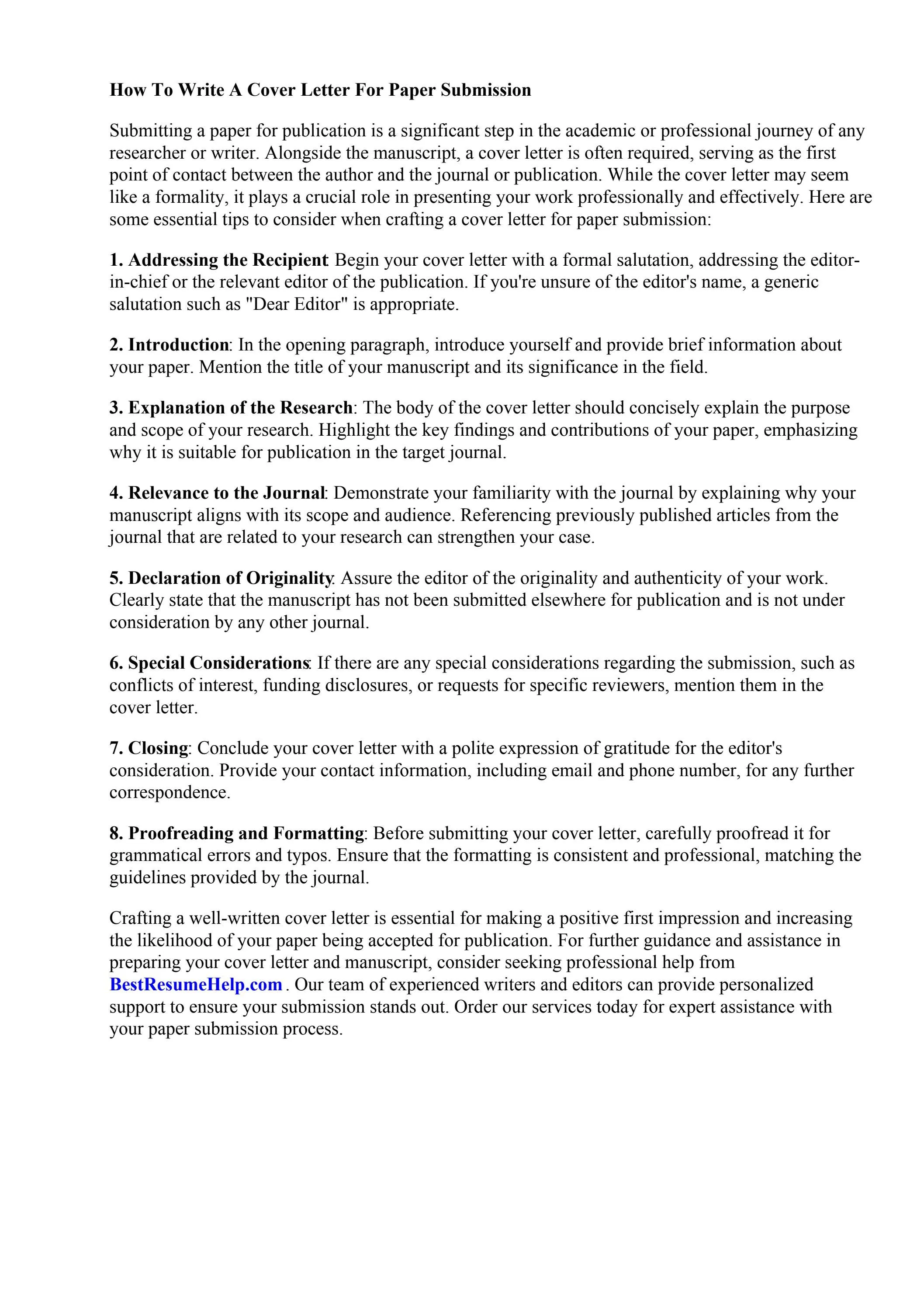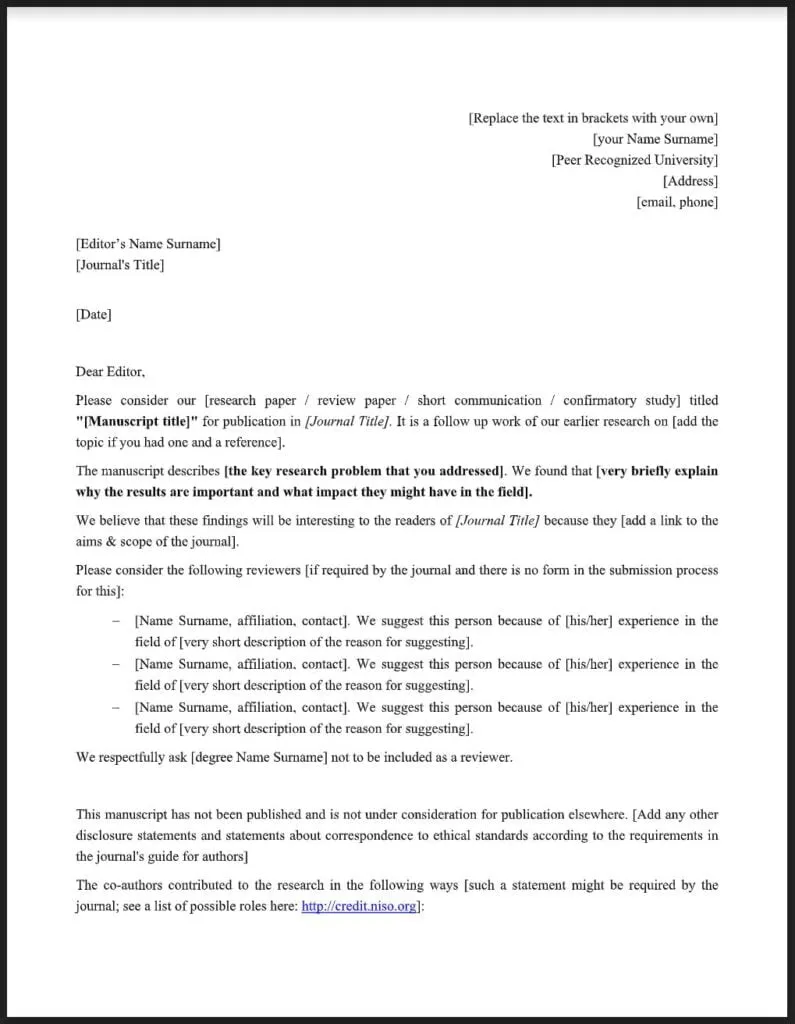What is a Cover Letter for Paper Submission?
A cover letter for paper submission is a crucial document that accompanies your research manuscript when you send it to a journal for consideration. It’s your first and often only chance to make a strong impression on the editor and convey the importance and suitability of your work for their publication. Think of it as a formal introduction to your research, setting the stage for the editor’s decision to send your paper out for peer review. The cover letter is not merely a formality it’s a strategic communication tool, a concise summary of your paper designed to capture the editor’s attention and persuade them that your research deserves their attention.
Why Is a Cover Letter Important?
The importance of a well-crafted cover letter cannot be overstated. It’s the initial point of contact, and it sets the tone for the entire submission process. A compelling cover letter can significantly increase the chances of your manuscript being considered for publication, while a poorly written one can lead to immediate rejection, even if your research is excellent. The cover letter allows you to provide context for your research, explaining its significance, novelty, and why it aligns with the journal’s scope and readership. It gives you the opportunity to address any potential concerns the editor might have and highlight the key strengths of your work. Essentially, it’s your personal advocate, working tirelessly to make sure your research gets a fair assessment.
Key Components of a Cover Letter

A standard cover letter generally includes several key components that work together to present your research effectively. These elements help structure the letter, ensuring you convey all the essential information clearly and concisely. The precise structure might vary slightly depending on the journal’s guidelines, but the core components remain consistent. These include the author’s contact information, a clear statement of the paper’s title and type, a brief summary of the research, a statement about the paper’s novelty and significance, a confirmation that all authors have approved the submission, a statement regarding potential conflicts of interest and funding, and often, a suggestion of potential reviewers. Each component plays a crucial role in painting a complete picture of your research.
Author’s Contact Information and Paper Details
Start your cover letter by providing the necessary contact information for the corresponding author. This typically includes your full name, affiliation, email address, and phone number. This section ensures the editor can easily reach you for any questions or decisions related to your manuscript. Immediately below your contact information, clearly state the title of your paper and specify the type of manuscript you are submitting (e.g., original research article, review, case study). This allows the editor to immediately identify the paper and its intended category. Also, include the date of submission to maintain a record of the correspondence. Make sure that the title matches the manuscript exactly. Accuracy in this initial section is critical.
Highlighting Research Significance and Novelty
This is arguably the most critical part of your cover letter. In a few concise sentences, explain the significance of your research and highlight its novelty. Explain why your work matters, what problem it addresses, or what new insights it offers. Clearly articulate the paper’s main findings and how they contribute to the existing body of knowledge. Emphasize the unique aspects of your research what makes it stand out from previous studies. Avoid jargon and use language that is accessible to a broad audience within the journal’s scope. State clearly the specific contribution of your research to the field and its implications for future studies or applications. This is your opportunity to persuade the editor that your work is worth their attention.
Addressing the Target Journal’s Specific Requirements

Carefully review the journal’s guidelines for authors before you start writing your cover letter. Tailor your letter to meet the specific requirements of the target journal. This may involve addressing specific criteria or expectations outlined by the journal. For example, some journals require you to explicitly state how your research aligns with their scope, audience, or specific themes they are interested in. Mention the journal by name and express your understanding of its aims and scope. You may also be required to justify why you believe your work is a good fit for this particular journal, and how your paper complements previously published articles in the same journal. Following these guidelines demonstrates your respect for the journal’s editorial policies and increases the likelihood of your paper being considered favorably.
Mentioning Potential Conflicts of Interest and Funding Sources
Transparency is crucial in academic publishing. Declare any potential conflicts of interest that may have influenced your research or its interpretation. This could include financial interests, affiliations, or other relationships that might be perceived as biases. Even if you believe there is no conflict, it’s best to explicitly state that the authors declare no conflicts of interest. Also, disclose all sources of funding for your research, including grant numbers and funding agencies. Providing this information ensures your research adheres to ethical guidelines and enhances its credibility. This information helps the editor and potential reviewers to assess the objectivity and reliability of your study. Failure to disclose these aspects can raise serious ethical concerns and may lead to rejection of your paper.
Suggesting Reviewers (If Applicable)
Some journals allow or even encourage authors to suggest potential reviewers for their manuscript. If the journal provides this option, carefully consider your choices. Suggest individuals who are experts in your field, who are not directly affiliated with you or your co-authors, and who have no apparent conflicts of interest. Provide the names, affiliations, and email addresses of your suggested reviewers. Also, it’s customary to indicate any individuals you would prefer not to review your paper. This may be based on previous disagreements or potential conflicts. Keep in mind that the editor is under no obligation to use your suggestions, but they can be helpful in accelerating the review process. When choosing reviewers, keep in mind that they should have no conflicts of interest and must be experts in the same domain as your paper.
Formatting and Style Tips

Maintain a professional and respectful tone throughout your cover letter. Address the editor by name if possible, and always use formal language. Keep the letter concise and focused, typically no longer than one page. Use clear and concise language, avoiding jargon or overly complex sentences. Proofread the letter carefully for any grammatical errors, spelling mistakes, or typos. Use a standard font and formatting, such as Times New Roman or Arial, with a font size of 12 points. Ensure the letter is well-organized with clear paragraphs and logical flow. Adhere to any specific formatting guidelines provided by the target journal. Attention to formatting and style reflects your attention to detail and professionalism.
Proofreading and Editing Your Cover Letter
Before submitting your cover letter, carefully proofread and edit it to ensure accuracy and clarity. Check for any grammatical errors, spelling mistakes, punctuation issues, or formatting inconsistencies. Read the letter aloud to identify any awkward phrasing or unclear sentences. Consider having a colleague or co-author review the letter for you to provide an objective perspective. Make sure your co-authors have also approved the final version of the letter. This step is crucial because a poorly written cover letter can damage the first impression you make on the editor and reviewers. Ensure the letter reflects your research’s quality and demonstrates your attention to detail. Polish your cover letter to perfection.
Finalizing and Submitting Your Cover Letter
Once you are satisfied with your cover letter, make sure you have all necessary attachments and supplemental materials prepared. Follow the journal’s submission guidelines carefully regarding file formats and submission procedures. Double-check that all information, including the title, authors, and manuscript type, is accurate. Submit your cover letter along with the manuscript through the journal’s online submission system or via email, as instructed by the journal. Keep a copy of the cover letter and your submitted manuscript for your records. After submission, monitor your email for any communication from the journal. Always respond to the editor’s requests promptly. Submitting a well-crafted cover letter is a key step in the publication process, increasing your paper’s chances for acceptance.
